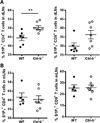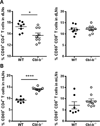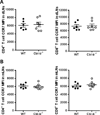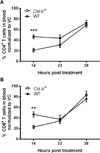Cbl-b-deficient mice express alterations in trafficking-related molecules but retain sensitivity to the multiple sclerosis therapeutic agent, FTY720
- PMID: 25829233
- PMCID: PMC4420730
- DOI: 10.1016/j.clim.2015.03.018
Cbl-b-deficient mice express alterations in trafficking-related molecules but retain sensitivity to the multiple sclerosis therapeutic agent, FTY720
Abstract
The variable response to therapy in multiple sclerosis (MS) suggests a need for personalized approaches based on individual genetic differences. GWAS have linked CBLB gene polymorphisms with MS and recent evidence demonstrated that these polymorphisms can be associated with abnormalities in T cell function and response to interferon-β therapy. Cbl-b is an E3 ubiquitin ligase that regulates T cell activation and Cbl-b-deficient (Cbl-b(-/-)) mice show T cell abnormalities described in MS patients. We now show that Cbl-b(-/-) T cells demonstrate significant lymph node trafficking abnormalities. We thus asked whether the MS-approved drug, FTY720, postulated to trap T cells in lymphoid tissues, is less effective in the context of Cbl-b dysfunction. We now report that FTY720 significantly inhibits EAE in Cbl-b(-/-) mice. Our results newly document a role for Cbl-b in T cell trafficking but suggest nevertheless that MS patients with Cbl-b abnormalities may still be excellent candidates for FTY720 treatment.
Keywords: Casitas-B lineage lymphoma-b; Experimental autoimmune encephalomyelitis; FTY720; Multiple sclerosis; Sphingosine-1-phosphate receptor 1; T cell trafficking.
Copyright © 2015 Elsevier Inc. All rights reserved.
Conflict of interest statement
The author (s) declare that there are no conflicts of interest.
Figures







Similar articles
-
FTY720 (fingolimod) in Multiple Sclerosis: therapeutic effects in the immune and the central nervous system.Br J Pharmacol. 2009 Nov;158(5):1173-82. doi: 10.1111/j.1476-5381.2009.00451.x. Epub 2009 Oct 8. Br J Pharmacol. 2009. PMID: 19814729 Free PMC article. Review.
-
FTY720 impairs CD8 T-cell function independently of the sphingosine-1-phosphate pathway.J Neuroimmunol. 2014 May 15;270(1-2):13-21. doi: 10.1016/j.jneuroim.2014.03.007. Epub 2014 Mar 11. J Neuroimmunol. 2014. PMID: 24680062
-
FTY720 (fingolimod) efficacy in an animal model of multiple sclerosis requires astrocyte sphingosine 1-phosphate receptor 1 (S1P1) modulation.Proc Natl Acad Sci U S A. 2011 Jan 11;108(2):751-6. doi: 10.1073/pnas.1014154108. Epub 2010 Dec 21. Proc Natl Acad Sci U S A. 2011. PMID: 21177428 Free PMC article.
-
FTY720 therapy exerts differential effects on T cell subsets in multiple sclerosis.Neurology. 2008 Oct 14;71(16):1261-7. doi: 10.1212/01.wnl.0000327609.57688.ea. Neurology. 2008. PMID: 18852441
-
Discovery of fingolimod, the sphingosine 1-phosphate receptor modulator and its application for the therapy of multiple sclerosis.Future Med Chem. 2012 Apr;4(6):771-81. doi: 10.4155/fmc.12.25. Future Med Chem. 2012. PMID: 22530640 Review.
Cited by
-
Therapeutic Value of Single Nucleotide Polymorphisms on the Efficacy of New Therapies in Patients with Multiple Sclerosis.J Pers Med. 2021 Apr 23;11(5):335. doi: 10.3390/jpm11050335. J Pers Med. 2021. PMID: 33922540 Free PMC article. Review.
-
Recycling and Reshaping-E3 Ligases and DUBs in the Initiation of T Cell Receptor-Mediated Signaling and Response.Int J Mol Sci. 2022 Mar 22;23(7):3424. doi: 10.3390/ijms23073424. Int J Mol Sci. 2022. PMID: 35408787 Free PMC article. Review.
-
Translational utility of experimental autoimmune encephalomyelitis: recent developments.J Inflamm Res. 2015 Nov 13;8:211-25. doi: 10.2147/JIR.S76707. eCollection 2015. J Inflamm Res. 2015. PMID: 26622189 Free PMC article. Review.
-
Deubiquitylating enzymes: potential target in autoimmune diseases.Inflammopharmacology. 2021 Dec;29(6):1683-1699. doi: 10.1007/s10787-021-00890-z. Epub 2021 Nov 18. Inflammopharmacology. 2021. PMID: 34792672 Review.
-
Cbl-b Deficiency Mediates Resistance to Programmed Death-Ligand 1/Programmed Death-1 Regulation.Front Immunol. 2017 Jan 26;8:42. doi: 10.3389/fimmu.2017.00042. eCollection 2017. Front Immunol. 2017. PMID: 28184224 Free PMC article.
References
-
- International Multiple Sclerosis Genetics, C. Hafler DA, Compston A, Sawcer S, Lander ES, Daly MJ, De Jager PL, de Bakker PI, Gabriel SB, Mirel DB, et al. Risk alleles for multiple sclerosis identified by a genomewide study. N Engl J Med. 2007;357:851–862. - PubMed
-
- International Multiple Sclerosis Genetics, C., C. Wellcome Trust Case Control. Sawcer S, Hellenthal G, Pirinen M, Spencer CC, Patsopoulos NA, Moutsianas L, Dilthey A, Su Z, et al. Genetic risk and a primary role for cell-mediated immune mechanisms in multiple sclerosis. Nature. 2011;476:214–219. - PMC - PubMed
-
- Bachmaier K, Krawczyk C, Kozieradzki I, Kong YY, Sasaki T, Oliveira-dos-Santos A, Mariathasan S, Bouchard D, Wakeham A, Itie A, et al. Negative regulation of lymphocyte activation and autoimmunity by the molecular adaptor Cbl-b. Nature. 2000;403:211–216. - PubMed
-
- Chiang YJ, Kole HK, Brown K, Naramura M, Fukuhara S, Hu RJ, Jang IK, Gutkind JS, Shevach E, Gu H. Cbl-b regulates the CD28 dependence of T-cell activation. Nature. 2000;403:216–220. - PubMed
Publication types
MeSH terms
Substances
Grants and funding
LinkOut - more resources
Full Text Sources
Other Literature Sources
Medical
Miscellaneous

